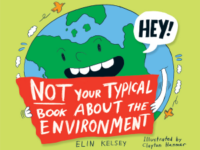
“No matter where you look, you’re bombarded with these hopeless messages about the future of our planet…. All that doom and gloom stuff is only half the story. You are not nature’s bogeyman. You are nature. You’re connected to this great wide world in ways beyond your wildest imagination…. These connections mean that you have power…. The power to choose!”
So proclaims Elin Kelsey in the introduction of her book, Not Your Typical Book About the Environment (Owl Kids, 64 pages, illustrated by Clayton Hanmer). Although written for children, this engaging book provides an interesting read for adults as well. What better way to share your environmental enthusiasm than with a young reader?
Broken into four sections covering clothing, food, technology, and energy, the book takes frequent and entertaining dives into dozens of topics. These are stories about innovation and persistence in solving problems and meeting human needs in ways that are more sustainable. Some are more speculative, like replacing wool with a fiber made from chicken feathers, while others are more established, such as the production of fleece clothing from recycled plastic bottles. Each tidbit is enough to spark the reader’s curiosity without dulling their interest with an avalanche of facts.
In an effort to sway opinion, or perhaps just to entertain, much that is written about the environment is alarmist and confrontational. Kelsey takes a more optimistic approach. She describes the forces at work and opposing views with more detachment: “The challenge of growing food, of course, is that many issues are complicated. New maps show that the Earth is rapidly running out of fertile farmland. At the same time, the world’s population is growing, growing, growing! Is Captain Industrial Agriculture a hero because he can produce high yields of food? Or is he a villain because he uses so much petroleum-based chemicals and water to do so? The real question isn’t whether it’s good or bad. Instead, we need to creatively combine different styles of farming to produce enough food while reducing our need for fossil fuels, improving water and soil quality, and preserving wildlife and wild places,” Kelsey says.
While clothes and food are important to children, the section on technology will really grab their attention. Music, social media, and video games are in their wheelhouse. It is important that they understand the environmental impact of all their devices. And, they will be interested to learn how technology helps us understand marine life and how satellites have helped us to map the entire world.
The last section on energy is called “People Power” and includes many tantalizing technologies, such as movement powering stadium lights or MP3 players, or human waste being transformed into electricity. As in earlier sections, it details the interconnectedness of things and lets children know what they can do to help save penguins. (Hint: Ride a bike.)
Even adults who consider themselves well-informed about environmental matters will learn something new here.
